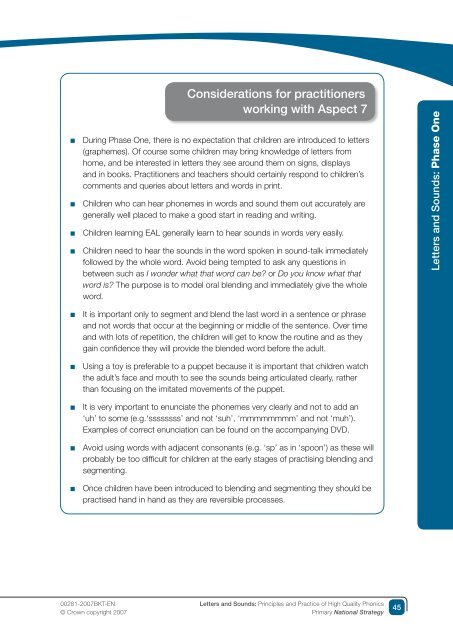Letters and Sounds 1
Letters and Sounds 1
Letters and Sounds 1
Create successful ePaper yourself
Turn your PDF publications into a flip-book with our unique Google optimized e-Paper software.
00281-2007BKT-EN<br />
© Crown copyright 2007<br />
Considerations for practitioners<br />
working with Aspect<br />
■ During Phase One, there is no expectation that children are introduced to letters<br />
(graphemes). Of course some children may bring knowledge of letters from<br />
home, <strong>and</strong> be interested in letters they see around them on signs, displays<br />
<strong>and</strong> in books. Practitioners <strong>and</strong> teachers should certainly respond to children’s<br />
comments <strong>and</strong> queries about letters <strong>and</strong> words in print.<br />
■ Children who can hear phonemes in words <strong>and</strong> sound them out accurately are<br />
generally well placed to make a good start in reading <strong>and</strong> writing.<br />
■ Children learning EAL generally learn to hear sounds in words very easily.<br />
■ Children need to hear the sounds in the word spoken in sound-talk immediately<br />
followed by the whole word. Avoid being tempted to ask any questions in<br />
between such as I wonder what that word can be? or Do you know what that<br />
word is? The purpose is to model oral blending <strong>and</strong> immediately give the whole<br />
word.<br />
■ It is important only to segment <strong>and</strong> blend the last word in a sentence or phrase<br />
<strong>and</strong> not words that occur at the beginning or middle of the sentence. Over time<br />
<strong>and</strong> with lots of repetition, the children will get to know the routine <strong>and</strong> as they<br />
gain confidence they will provide the blended word before the adult.<br />
■ Using a toy is preferable to a puppet because it is important that children watch<br />
the adult’s face <strong>and</strong> mouth to see the sounds being articulated clearly, rather<br />
than focusing on the imitated movements of the puppet.<br />
■ It is very important to enunciate the phonemes very clearly <strong>and</strong> not to add an<br />
‘uh’ to some (e.g.‘ssssssss’ <strong>and</strong> not ‘suh’, ‘mmmmmmmm’ <strong>and</strong> not ‘muh’).<br />
Examples of correct enunciation can be found on the accompanying DVD.<br />
■ Avoid using words with adjacent consonants (e.g. ‘sp’ as in ‘spoon’) as these will<br />
probably be too difficult for children at the early stages of practising blending <strong>and</strong><br />
segmenting.<br />
■ Once children have been introduced to blending <strong>and</strong> segmenting they should be<br />
practised h<strong>and</strong> in h<strong>and</strong> as they are reversible processes.<br />
<strong>Letters</strong> <strong>and</strong> <strong>Sounds</strong>: Principles <strong>and</strong> Practice of High Quality Phonics<br />
Primary National Strategy<br />
<strong>Letters</strong> <strong>and</strong> <strong>Sounds</strong>: Phase One
















